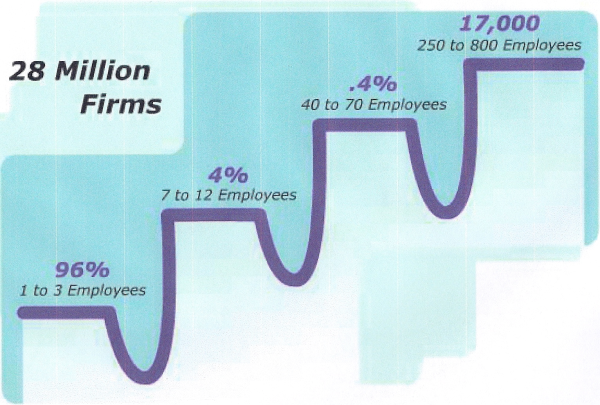Very few companies grow beyond $1 Million in revenue. Did realize that of the 29.6 million businesses in the United States only about 0.4% ever pass $10 million in revenue?-resized-600.jpg?width=378&height=255&name=evolution_(firm_size)-resized-600.jpg)
Although a half a million new firms are born each year, 52% fail by their 5th year in business. While the numbers surrounding bankruptcies have dropped since 2010, 1.2 million businesses filed bankruptcy in 2012. That still can be considered alarming.
What prevents companies from breaking through to the $10M barrier? What obstacles and issues should you be aware of and be ready to overcome in order to achieve this level of success?
According to Verne Harnish, Mastering the Rockefeller Habits (a book I highly recommend for any business owner wishing to achieve high levels of growth for his business) the three barriers to growth are:
- The need for the executive team to grow as leaders in their abilities to delegate and predict.
- The need for systems and structures to handle the complexity that comes with growth.
- The need to navigate the increasingly tricky market dynamics that mark arrival in a larger marketplace.
Over the next several blog we’ll look at each of these, what they entail, and how Positioning Systems through it certified coaching affiliation with Gazelles/Rockefeller Habitsand pervious ten years as a Senior Consultant for E-Myth Worldwide can provide in terms of tools, resources, training, and coaching experience to help your company overcome these 3 barriers:
1. The need for the executive team to grow as leaders in their abilities to delegate and predict. (PEOPLE)
As addressed in the Rockefeller Habits Checklist, as the leadership team goes, so goes the rest of the firm. The strengths and weaknesses in your organization can be traced right back to the cohesion of the executive team and their levels of Trust, Competence, Discipline, Alignment, and Respect. The two most important attributes of effective leaders is their ability to predict and to delegate. In forecasting/predicting we include the ability to set a compelling vision that anticipates market movement. You don’t have to be years ahead, just minutes ahead of the market, competition and those that lead. Look at Wall Street. The ability to accurately predict earnings and revenues is the ultimate test of leadership.
When you look at the second attribute of leadership you quickly understand why most firms have fewer than ten employees. One of the hardest aspects of leadership, but absolutely necessary in order to grow your firm, is being able to get others to do something as good as or better then yourself. To get to ten employees, the founder(s) must begin to delegate those functions which they are weak at. As your organization grows to 50, whatever is the strength of the top leader can frequently become the weakness in the organization. Over 50, you need to add layers of mid-level and frontline leaders. The success of the firm is determined by how well the senior leadership team grows the next level of leadership, teaching them as well to predict and delegate effectively.
How do you become good at delegating? First step is to choose the right person.  One of Jack Welch’s rules at GE is better people, “Less people, paid more with a lower total wage cost.” One of our Rockefeller Habits clients, The Container Store, has a philosophy that one great person can replace three good people. When you have the right people delegation is a simple four-step process to pinpoint what they are to do, creating a measurement system for monitoring progress, providing feedback, and then giving out appropriate timed recognition and reward.
One of Jack Welch’s rules at GE is better people, “Less people, paid more with a lower total wage cost.” One of our Rockefeller Habits clients, The Container Store, has a philosophy that one great person can replace three good people. When you have the right people delegation is a simple four-step process to pinpoint what they are to do, creating a measurement system for monitoring progress, providing feedback, and then giving out appropriate timed recognition and reward.
Positioning Systems will help train you on how to select the right people who have the talents and abilities to lead. With Strategic Discipline we give you the tools and resources to continuously train your people. Teach them the foundational principles necessary to grow your business and to help you stay abreast of best practices and the top thought leaders whose ideas influence change and contribute to the world’s expanding economy. The meeting rhythms we help you set up provide communication and develop the insight and feedback your people need to predict trends internally and externally so they can more accurately forecast the future.
The two remaining barriers to growth require further discussion and analysis to help you understand what they are and why they prevent your business growth. We’ll explore how to overcome these barriers. We’ll look at the second barrier to growth: the need for systems and structures to handle the complexity that comes with growth, and the solution (EXECUTION) in our next blog!






.jpeg?width=150&height=135&name=Hand%20with%20marker%20writing%20the%20question%20Whats%20Next_%20(1).jpeg)

